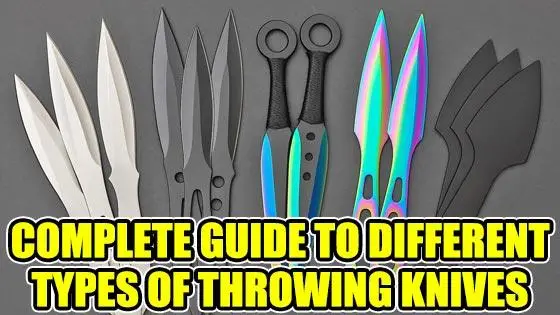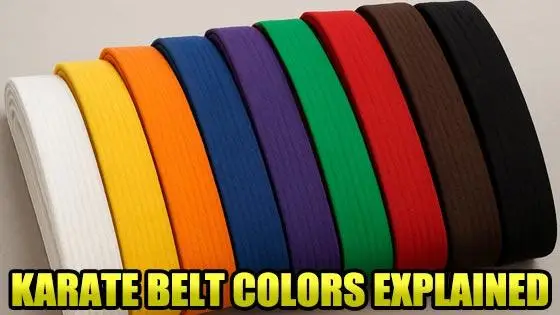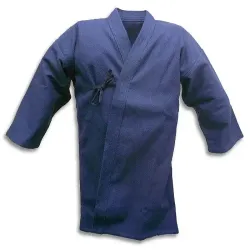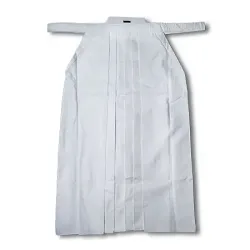Kendo Uniforms - Hakama & Keikogi - Samurai Costume
-
$56.95
-
$52.95
-
$54.95
-
$59.95
A kendo uniform, often called a kendogi (or kendo gi), is more than just a piece of clothing. It's an important part of the training process, worn by practitioners during their practice sessions and competitions. The kendogi consists of two main components: the keikogi and the hakama. While many martial arts have their own unique uniforms, the kendo gi stands out due to its historical significance and practical design.
The keikogi (or juban shitagi in some cases) is the top half of the kendo uniform, and it is typically a thick, durable cotton jacket. The design of the keikogi is similar to that of a traditional karate gi but with some distinct differences. The sleeves are typically shorter, which allows greater freedom of movement during practice, especially during the execution of strikes and defensive maneuvers. In some styles, the keikogi is worn under the armor (called bogu), while in others, like iaido or iaitoka practice, it may be worn without armor. Regardless of the style, the keikogi offers a snug yet comfortable fit, ensuring that practitioners can perform their techniques with ease.
The bottom half of the kendo uniform is the hakama, which is a pleated, wide-legged garment that resembles a skirt but is actually a pair of baggy pants. The hakama originated in the samurai era and was designed to be worn by warriors during horseback riding. It's more than just a traditional piece of clothing; it represents the disciplined and honorable nature of the samurai and their deep connection to bushido (the way of the warrior). The hakama is worn with the pleats facing forward, symbolizing various virtues, such as justice, courage, and wisdom.
In kendo, the hakama is typically worn in black, although other colors like blue or purple are also common in certain schools or dojo. The color of the hakama is a reflection of the practitioner's rank and the dojo's traditions. For example, black is often reserved for higher-ranked practitioners, while lighter colors might be seen in beginners' uniforms.
The combination of the keikogi and hakama forms the foundation of a kendoka uniform. These two pieces are essential for anyone practicing kendo, as they allow for freedom of movement while maintaining the traditional aesthetics of the martial art. The kendogi is generally made from a tough, high-quality cotton or a cotton-blend fabric, which holds up to the rigorous training involved in kendo. The hakama, made from a thicker fabric, provides the flexibility needed for swift footwork and dynamic movement.
While kendo is the most well-known martial art to use the kendogi, there are other martial arts that incorporate similar uniforms, such as iaido, iaitoka, and shinkendo. In iaido, practitioners focus on the art of drawing and cutting with a sword, and like in kendo, wearing a keikogi and hakama is a key part of the tradition. The iaido uniform, also called the iaido gi, often features a more streamlined design, focusing on simplicity and functionality. It's common for iaidoka to wear a keikogi without the heavy armor seen in kendo, as the focus is on precise, controlled movements with a katana, rather than sparring.
Similarly, shinkendo, a modern swordsmanship style created by Sensei Kenji Tokitsu, also adheres to the tradition of wearing kendo uniforms. In fact, many styles of kenjutsu (traditional Japanese swordsmanship) require their practitioners to wear kendogi and hakama, emphasizing the importance of martial discipline, respect for tradition, and connection to the samurai way.
The historical roots of the kendogi can be traced back to the samurai period of Japan. During this time, warriors would wear simple yet effective clothing designed to allow ease of movement and provide comfort during long training sessions. As modern kendo developed into the sport we know today, the uniform was refined and adapted to suit the needs of the art. The basic design of the kendogi and hakama has remained largely unchanged, as it serves both practical and symbolic purposes.
For those who practice kendo or other sword arts, choosing the right kendoka uniform is crucial. A good-quality kendogi should be durable enough to withstand the wear and tear of regular training. The fabric should be breathable and able to absorb sweat, as intense training sessions can leave you drenched. The hakama should fit comfortably and allow for unhindered movement, especially when executing quick footwork and high-impact strikes.
At KarateMart.com, we understand that a samurai costume or samurai outfit can also be a fun and unique way to experience the warrior culture, whether for cosplay, Halloween, or other themed events. Our samurai uniforms are made with attention to detail, giving you an authentic look that captures the spirit of the samurai. Whether you're looking for a classic kendo uniform for training or a samurai gi for cosplay, we have a wide range of options to suit your needs.
If you're just starting out in kendo or iaido, you may wonder what makes a good kendoka gi stand out. It's not just about the look; it's about comfort, durability, and authenticity. The best kendo uniforms are made from high-quality materials that are designed to last through intense practice. You'll want a keikogi that holds up to repeated washing without losing its shape, and a hakama that remains flexible and comfortable over time.
For those involved in iaido, wearing the right iaido gi or iaitoka uniform is just as important. While the focus in iaido is on precise, controlled movements with a katana, having a uniform that fits properly can help you move fluidly through each kata. The juban shitagi (underwear or undershirt) worn with the keikogi is also an essential component in iaido uniforms, ensuring that the top garment stays in place and doesn't shift during practice.
When choosing a kendogi or any kendo-related uniform, it's important to consider not only the quality of the material but also the fit. Too tight and you won't be able to move freely; too loose and the uniform may get in the way of your movements. A well-fitting kendoka gi allows you to focus on your training without distractions.
Whether you are a dedicated kendoka, a beginner iaido student, or simply someone with an appreciation for samurai culture, investing in a high-quality kendo uniform can make a huge difference in your martial arts experience. At KarateMart.com, we offer kendogi, keikogi, hakama, and all the essential pieces for kendo, iaido, and other related martial arts. With our wide selection of uniforms, you'll find everything you need to train in style, whether you're in the dojo or participating in cosplay events. And, of course, don't forget to make sure you get your own Kendo Shinai.
What's the Difference Between a Kendo Uniform and a Karate Gi?
While both are martial arts uniforms, a kendo uniform (often called a kendo gi or kendogi) is built for a completely different purpose than a karate gi. Kendo involves fast footwork, strikes with a shinai, and plenty of sweat, so the uniform needs to handle friction and absorb impact. The keikogi top is made from thicker cotton with a rough, quilted weave that helps protect the skin under the armor, or bogu. The top is paired with a pleated hakama instead of pants, which provides freedom of movement and maintains traditional Japanese style.
A karate gi, on the other hand, is typically made from lightweight canvas or cotton and features a smoother surface for striking and grappling. It includes a simple jacket and pants secured with a belt, allowing speed and flexibility without added weight. While they may look similar from a distance, a kendo uniform is heavier, more textured, and designed to endure the demands of sword-based practice rather than open-hand techniques.
What's the Difference Between a Keikogi and a Hakama?
A complete kendo uniform consists of two main pieces: the keikogi and the hakama. The keikogi, often called a kendo gi or kendogi, is the upper jacket worn under the armor. It is usually made from thick, absorbent cotton with a textured weave that helps wick away sweat and protect the body during practice. The keikogi is designed to be strong, breathable, and comfortable, allowing free movement during strikes and footwork drills.
The hakama is the pleated bottom that gives the kendo uniform its distinctive traditional look. It appears like a skirt but actually has two wide pant legs hidden within the folds. The hakama is tied securely around the waist and helps teach balance and discipline while concealing the movement of the legs. Together, the keikogi and hakama form the traditional kendo uniform, combining function, durability, and cultural tradition in every practice session.
How Should a Kendo Uniform Fit?
A proper kendo uniform should balance comfort, mobility, and tradition. The keikogi, sometimes called a kendo gi, should fit loosely enough to allow free arm movement during strikes but not so baggy that it gathers under the armor or restricts airflow. The sleeves should fall just above the wrists, and the hem should reach slightly past the waist so it stays tucked beneath the hakama during practice. Many practitioners prefer a slightly heavier weave for the keikogi because it absorbs sweat better and maintains its shape over time.
The hakama should sit high on the waist, with the front pleats hanging evenly and the hem reaching just above the tops of the feet. When tied correctly, the hakama should feel snug but not tight around the midsection. If it's too long, the pleats can drag or fold awkwardly, affecting footwork and balance. When both pieces fit well, the kendo uniform moves naturally with the body, allowing proper posture and technique without distraction.
Can I Use My Kendo Uniform for Iaido or Kenjutsu Practice?
It's possible to wear a kendo uniform for iaido or kenjutsu, but it's not ideal for long-term use. While the keikogi and hakama may look similar across these sword arts, each style has unique requirements that affect comfort and performance. A kendo keikogi is usually thicker and designed to be worn under bogu armor, which means it can feel heavy or hot during iaido practice. In contrast, an iaido keikogi or iaido uniform is lighter and cut with more room in the shoulders and sleeves for smoother sword draws and sheath work.
The hakama used in kendo and iaido are also slightly different. Kendo hakama are typically made from heavier material to withstand contact and fast footwork, while iaido versions use lighter, smoother fabrics that glide more easily as you kneel or perform kata. If you train in both arts, many practitioners recommend owning one uniform for each to maintain comfort and proper form.
How Do I Properly Fold and Care for a Kendo Hakama?
Folding a kendo hakama correctly is an important part of training, showing respect for the uniform and keeping it in good condition. To fold it properly, start by laying the hakama flat with the pleats facing upward. Smooth out each pleat so it aligns neatly from top to bottom. Fold both sides inward toward the center, making sure the pleats stay straight. Then, fold the bottom of the hakama up to the waistband in thirds or halves, depending on the length. Wrap the long ties neatly around the folded garment to secure it before storing it in a dry, clean place.
To care for your hakama, avoid using a washing machine unless the label specifically says it's safe. Indigo-dyed cotton can bleed color, so hand washing in cold water is usually best. Use mild detergent, rinse thoroughly, and hang it to dry away from direct sunlight to prevent fading. Light ironing may help maintain the crisp pleats, but always use a low heat setting or place a thin cloth between the iron and the fabric to avoid scorching.
What Do the Pleats on a Hakama Represent?
The pleats on a hakama are not just decorative. Each one carries a symbolic meaning that reflects the values of the martial arts. Traditionally, a hakama has seven pleats, five in the front and two in the back. The five front pleats represent the virtues of rectitude, courage, benevolence, respect, and honesty. The two back pleats symbolize loyalty and honor. Together, these seven virtues serve as a reminder that training in kendo is not only about improving physical skill but also about developing strong character and discipline.
When you put on or fold your hakama, taking care to align the pleats properly shows respect for these principles and for the art itself. In many dojos, instructors emphasize the importance of maintaining these pleats as a daily act of mindfulness and appreciation for the traditions passed down through generations.
Should Beginners Wear a Hakama, or Only Advanced Kendo Students?
In most kendo dojos, beginners start training in a keikogi and simple practice pants before moving on to wearing a hakama. This allows new students to focus on footwork, posture, and basic techniques without worrying about maintaining the folds or ties of a hakama. Once a student demonstrates good discipline and a clear understanding of etiquette, they are usually permitted or encouraged to wear one. The timing varies by dojo, but many instructors see the hakama as a symbol of commitment to serious training rather than just a piece of clothing.
That said, some schools allow beginners to wear a hakama from day one to help them learn the proper way to move and bow while wearing traditional attire. Either approach is acceptable as long as it supports the student's progress and respect for kendo tradition. The most important thing is to wear the uniform neatly and train with focus and humility, regardless of rank or experience.
What's the Difference Between a Kendo Keikogi and a Karate Gi Top?
Although both garments serve as martial arts tops, the kendo keikogi and karate gi are built for very different types of training. A kendo keikogi is made from thick, quilted cotton designed to absorb sweat and protect the skin under the armor, or bogu. Its heavy weave provides extra durability for long sessions involving fast movement and contact. The sleeves are slightly shorter to prevent interference with the wrists and sword grip, and the jacket is cut to stay tucked beneath the hakama during practice.
A karate gi top is generally lighter and smoother because it does not need to fit under protective armor. It allows more freedom of motion for punches, blocks, and kicks, and is usually made from canvas or lighter cotton that can withstand repeated washing. The lighter fabric also promotes airflow, keeping the practitioner cooler during intense workouts. While both are martial arts uniforms, the keikogi is built for endurance and protection, whereas the karate gi emphasizes speed and flexibility.
Can I Machine Wash a Kendo Gi and Hakama?
Machine washing a kendo uniform can be risky, especially if it is made from indigo-dyed cotton. The dye tends to bleed, and machine agitation can weaken the fabric over time. Most practitioners prefer to hand wash both the keikogi and hakama in cold water using a mild detergent. This method helps preserve the color and texture while preventing shrinkage. After washing, rinse thoroughly and hang the garments to air dry in a shaded area away from direct sunlight.
If your keikogi or hakama is made from a modern, colorfast fabric, you can use a gentle machine cycle with cold water, but it is best to place each piece in a mesh laundry bag for protection. Avoid bleach, strong detergents, and high heat, as these can damage the material or cause fading. Proper care not only keeps the uniform looking clean and crisp but also helps it last through years of regular training.
Why Do Kendo Practitioners Wear Hakama Instead of Pants?
Kendo practitioners wear a hakama instead of pants because it preserves the traditional clothing style of the samurai while serving a practical purpose during training. The wide, pleated design allows for full freedom of movement, especially when performing footwork, lunges, and turns. The flowing fabric also conceals the position of the legs, making it harder for an opponent to anticipate movement. This combination of form and function reflects the spirit of kendo, where precision and tradition are equally important.
The hakama is worn over the keikogi, the top portion of the kendo uniform, to complete the traditional appearance. The two garments together represent respect for history and discipline, linking modern kendo practitioners to the warriors who trained centuries ago. Wearing a hakama also encourages mindfulness, since keeping its pleats straight and properly tied requires patience and attention to detail.
What's the Historical Origin of the Kendo Uniform?
The kendo uniform has its roots in the clothing worn by samurai during the Edo period of Japan. The combination of keikogi and hakama evolved from the traditional garments used for sword practice and ceremonial training. Early practitioners of kenjutsu, the martial art that later became kendo, wore similar attire made from durable cotton or hemp to allow unrestricted movement while protecting the body during drills. Over time, these garments were standardized to form what is now recognized as the modern kendo uniform.
The keikogi was developed as a lightweight but sturdy top, while the pleated hakama maintained its place as a symbol of discipline and tradition. The design of both pieces was heavily influenced by samurai training clothing, known as juban shitagi, which was worn under armor. Today's kendo uniform honors this history by maintaining the same functional structure and cultural meaning, connecting modern practitioners to the centuries-old spirit of the Japanese sword arts.
What's the Difference Between Kendo and Samurai Uniforms?
While the kendo uniform is inspired by the clothing of the samurai, there are several important differences between the two. Samurai uniforms, often referred to as armor or battle attire, included layers of protective gear made from leather, metal, and lacquered plates. These materials were designed to protect the body in real combat. In contrast, a kendo uniform consists of a keikogi and hakama made from cotton or synthetic fabric, offering flexibility and comfort for practice rather than protection against weapons.
The purpose behind each uniform is also different. Samurai armor was made for warfare and carried symbolic elements reflecting the warrior's clan and rank. The modern kendo uniform is meant for training and discipline, focusing on tradition and form. It keeps the classic silhouette of samurai clothing but removes the heavy armor, allowing practitioners to move freely while preserving the art's historical roots. Wearing a kendo uniform pays respect to the samurai heritage while serving the practical needs of modern martial arts practice.

































